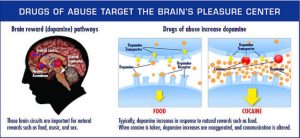Paul’s Health: Drug Addiction
Due to the results of substance abuse, Paul was often agitated, sweating, complaining of back pain. He was self-medicating with alcohol and prescription drugs, first from walk in clinics and eventually from the streets. At this point, he had long term disability. He was taking his mother-in-law’s post-op medications and denied having a “pill problem”. He stated that he was feeling overwhelmed with everything going on in his life.
What is drug addiction?
Drug addiction is an initial decision to take drugs is voluntary. Repeated drug use overwhelms receptor cells and can lead to brain changes that challenge self-control & resist urges. The natural capacity to produce dopamine in the reward center is reduced. Addictive drugs provide a shortcut to the brain’s reward center. Addicts may require higher doses and quicker passage into the brain.
The Brain’s Reward System

Addictive drugs provide a shortcut to the brain’s reward system by flooding the nucleus accumbens with dopamine. The hippocampus lays down memories of this rapid sense of satisfaction, and the amygdala creates a conditioned response to certain stimuli. The reward system may be more vulnerable, responses to stress more intense, or the formation of addictive habits quicker in some people, especially those suffering from depression, anxiety, or schizophrenia, and those with disorders like antisocial and borderline personality.
Why?
Biology
- Genes account for about half of a person’s risk for addiction
- Gender, ethnicity, and presence of other mental disorders
Environment
- Family & friends
- Economic status & general quality of life
- Peer pressure, physical & sexual abuse
- Early exposure to drugs, stress, and parental guidance
Development
- Genetic & environmental factors interact with critical developmental stages
- The earlier drug use begins, the more likely to become addicted
- Teens’ brains are still developing (decision-making, judgment, and self-control)
Overcoming A Drug
- Recognize you have a problem
- Decide to make a change
Committing to sobriety involves changing:
- The way you deal with stress
- Who you allow in your life
- What you do in your free time
- How you think about yourself
Treatment options:
- Detoxification
- Behavioral counseling
- Medication
- Long-term follow-up

